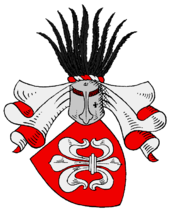Estorff (noble family)
Estorff , also Estorf , is the name of an old noble family from Lower Saxony . The family, some of whose branches still exist today, is related to the von Schack family , which also has a similar coat of arms .
There is no tribal relationship to the Bremen family von Estorp (later also Estorff ) in the Kehdinger Land mentioned by Kneschke , which died out in the first half of the 18th century. Their coat of arms shows in green a cut down above and below, lying diagonally to the right and branched twice on each side, silver tree trunk.
history

origin
The family is first mentioned in 1162 with Skaccus de Bardewic as a witness in a document from Duke Henry the Lion . Manegoldus de Esdorpe appears for the first time in 1212 with the name form, named after the Vrestorp estate near Bardowick . He is probably identical with the Mangold von Estorp mentioned in documents at the beginning of the 13th century as the son of Schackoni and brother of Eckhard. 1342 appears in a document Johann Schack, whose son Ekbert again expressly mentions himself from Estorp.
Spread and personalities
Another Mangold von Estorff is listed as lord of the castle of Lüneburg in 1281 , as is Conrad von Estorff in 1307. Ludolph von Estorff was provost of the cathedral in Halberstadt in 1448 and another Ludolph von Estorff in 1507 ducal privy councilor of Brunswick-Lüneburg , grandvogt of Celle and captain of Winsen .
Emerentia Catharina von Estorff was abbess from 1642 to 1667 and Dorothea Emerentia von Estorff from 1722 to 1731 at the Ebstorf monastery . Ludolph Otto von Estorff died in 1691 as Abbot to St. Michaelis in Lüneburg and first landscape director . Dietrich Hartwig von Estorff († 1700) became cathedral provost and senior at Havelberg , Brandenburg war commissioner and director of the Prignitz district. In 1729 Otto von Estorff was the royal British court judge in Celle and district administrator . During the 18th and 19th centuries, numerous members of the family served as officers in the ducal Lüneburg or royal Hanover and Prussian armies .
Baron
Georg Otto Carl von Estorff had held the title of baron for himself since his time as chamberlain with the exiled Dutch King Wilhelm I in Berlin in the early 1840s . His baron status is said to have been recognized by Dutch and Prussian diplomas. He died without male offspring.
Possessions
As early as 1292, members of the family acquired Gut Veerßen (today a part of Uelzen ) from von Hitzacker through purchase. In 1533 they voluntarily gave it to the sovereign as a fief . The oldest Lüneburg feudal letter was issued in 1487. In the later Kingdom of Hanover, the family belonged to the knightly nobility of the Lüneburg landscape due to the possession or partial ownership of the goods Barnstedt , Veerßen , Teyendorf and two other goods in Neetze and Bleckede . From the beginning and middle of the 19th century, members of the family were also wealthy in West Prussia , Posen and Franconia .
coat of arms
Family coat of arms
The coat of arms shows a silver lily lying obliquely to the right in red . On the helmet with red and silver covers, nine black black grouse feathers .
Coat of arms history
The Book of Arms of the Kingdom of Hanover (1852) shows the coat of arms with two forwards and inwards looking knights in golden armor as shield holders , whose helmets are equipped with a red and a silver ball and who hold a tournament lance in their free hand. The motto is soies ferme . In Johann Siebmacher's coat of arms book (1605) the coat of arms is listed under the Braunschweigische. Here the lily is placed obliquely to the left and of the nine feathers in the crest , five turn to the right and four to the left.
Christian Friedrich August von Meding , Nachrichten von Nobeligen Wappen (1788), adopts a lily lying obliquely to the left and says of the crest that it is different. In the windows of the monastery in Ebstorf, a coat of arms from 1651 shows five black grouse feathers on the bulging helmet, a coat of arms from 1659 shows five ostrich feathers, one from 1726 a silver field and one from 1755 a crowned helmet. Instead of the bulge, an old colored coat of arms had four alternating silver and red balls and, above these, five black grouse feathers, on the right and left of a downward-curved ostrich feather. According to Köhler, treatise of the silver ships betrothed to Alt-Oetting (1518), the lily in the shield was lying diagonally to the right.
Known family members
- Otto (VII.) Von Estorff (1566–1637), on Barnstedt and Veerßen, canon and from 1618 cathedral provost in the Schwerin monastery
- Ludolf von Estorff (1708–1779), Major General of the Elector of Brunswick-Lüneburg
- Emmerich Otto August von Estorff (1722–1796), lieutenant general of the Elector of Brunswick-Lüneburg
- Albrecht von Estorff (1766–1840), Hanoverian lieutenant general
- Wilhelm von Estorff († 1876), Hanoverian bailiff
- Georg Otto Carl von Estorff (1811–1877), German archaeologist
- August von Estorff (1811–1891), lawyer and member of the German Reichstag
- Eggert Ludwig von Estorff (1831–1903), Prussian major general and editor of the military weekly paper
- Friedhelm von Estorff (1932–2014), German photographer
- Ludolph Karl Adolf von Estorff (1838–1912), Prussian district administrator and district president in the district of Aurich 1892–1902
- Ludwig von Estorff (1859–1943), German infantry general
- Otto Carl von Estorff (1865–1929), German major general
- Otto von Estorff (1896–1974), German architect
- Randolf von Estorff (* 1957), German economist and manager
- Otto von Estorff (* 1957), German engineer and university professor for acoustics and numerical processes at the TU Hamburg
literature
- Genealogia Familiae Estorfiorum, Collecta Ex antiquis litteris & monumentis, ab incendio & hostili incursione conservatis / Per Ottonem ab Estorf, Ludolphi Filium, Ottonis Nepotem Et per Joannem Burmeisterum Lunaeburg ... Hamburg: Lange 1616
- Georg Otto Carl von Estorff : Brief outline of the family history of the Estorff's. Haag: Schinkel 1843 ( digitized version )
- Genealogical manual of the nobility , Adelslexikon. Volume III, Volume 61 of the complete series, p. 109, CA Starke Verlag , Limburg (Lahn) 1975, ISSN 0435-2408
- Deutsche Adelsgenossenschaft (Hrsg.): Yearbook of the German nobility . Volume 1, 1896, published by WT Bruer, p. 608ff. Digitized
- Ernst Heinrich Kneschke : New general German nobility lexicon . Volume 3, Friedrich Voigt's Buchhandlung, Leipzig 1861, p. 168. ( digitized version )
- Ernst Heinrich Kneschke : The coats of arms of the German baronial and noble families. Volume 2, TO Weigel, Leipzig 1855, pp. 140-142. ( Digitized version )
- Leopold von Zedlitz-Neukirch : New Prussian Adelslexicon . Supplement Volume 1, Gebrüder Reichenbach, Leipzig 1839, p. 149. ( digitized version )
- Hans-Cord Sarnighausen: Emmerich Otto August von Estorff (1722–1796), General Inspector of the Hanoverian Cavalry. in: Archives for family history research. Issue 4/2009, pp. 7-10; Home calendar Uelzen 2010, pp. 35–38.
- Hans-Cord Sarnighausen: To the Barnstedter grave slab v. Estorff and v. Ompteda from 1704. in: Archives for family history research. Issue 2/2013, pp. 54–56.
- Marcelli Janecki: Handbook of the Prussian Nobility. Volume 1, pp. 135ff.
Web links
- Coat of arms of the Estorff family in Johann Siebmacher's coat of arms book 1605
- Newspaper article about Estorff in the 20th century press kit of the ZBW - Leibniz Information Center for Economics .
Individual evidence
- ↑ a b Genealogisches Handbuch des Adels , Adelslexikon. Volume III, Volume 61 of the complete series, p. 109.
- ↑ a b c d New general German nobility lexicon. Volume 3, p. 168.
- ^ Document book of the city of Lübeck. I 2
- ^ City archive Hanover or Wilhelm von Hodenberg : Hoyer Urkundenbuch. VII. 6.
- ^ New general German Adels Lexicon Volume 8, p. 69.
- ↑ Gothaisches genealogical pocket book of the baronial houses. 10 (1860), pp. 188f.
- ↑ a b The coats of arms of the German baronial and aristocratic families , Volume 2, pp. 140–142.
- ↑ [1]

